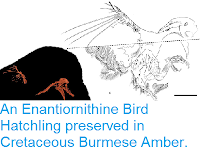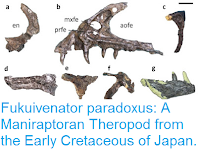The Troodontids were a group of small-to-medium sized Maniraptoran Theropod Dinosaurs known from the Cretaceous of Asia and North America. They were closely related to the Birds and Dromeosaurs, with the three groups being classified together as the Paraves. They had large brains and large forward pointing eyes, traits that would generally be associated with predatory behaviour, but their dentition implies a more complex story, with several species having small serrated teeth that would be on their own be taken as indicative of a browsing herbivorous diet, with the two together probably indicating some measure of omnivory.
In a paper published in the American Museum Novitates on 15 December 2017, Rui Pei of the Department of Earth Sciences at the University of Hong Kong, and the Division of Paleontology at the American Museum of Natural History, Mark Norell, also of the Division of Paleontology at the American Museum of Natural History, Daniel Barta of the Richard Gilder Graduate School and Division of Paleontology at the American Museum of Natural History, Gabriel Bever, again of the Division of Paleontology at the American Museum of Natural History, and of the Center for Functional Anatomy & Evolution at the Johns Hopkins University School of Medicine, Michael Pittman of the Vertebrate Palaeontology Laboratory at the University of Hong Kong, and Xing Xu of the Institute of Vertebrate Paleontology and Paleoanthropology of the Chinese Academy of Sciences, describe a new species of Troodontid Dinosaur from the Late Cretaceous Djadokhta Formation of Ukhaa Tolgod in the Ömnögovi Province of southern Mongolia.
The new species is named Almas ukhaa, where 'Almas' refers to a Yeti-like creature from Mongolian folklore and 'ukhaa' to the locality where the specimen was found. The species is described from a single specimen comprising a nearly complete skull and partial post-cranial skeleton, probably that of an almost mature sub-adult. The skull is about 82 mm in length, with four premaxilary (upper front) a teeth, a row of 16 maxilary teeth, smaller at the front and lacking serrations, and 23 dentary (lower) teeth, closer packed at the front.
The specimen was found associated with a number of eggshell fragments, which almost certainly came from a non-Avian Dinosaur, and quite possibly a Troodontid, though it is impossible to say what the actual relationship of these to the specimen is.
See also...
The specimen of Almas ukhaa. Pei et al. (2017).
The specimen was found associated with a number of eggshell fragments, which almost certainly came from a non-Avian Dinosaur, and quite possibly a Troodontid, though it is impossible to say what the actual relationship of these to the specimen is.
See also...
Follow Sciency Thoughts on Facebook.







